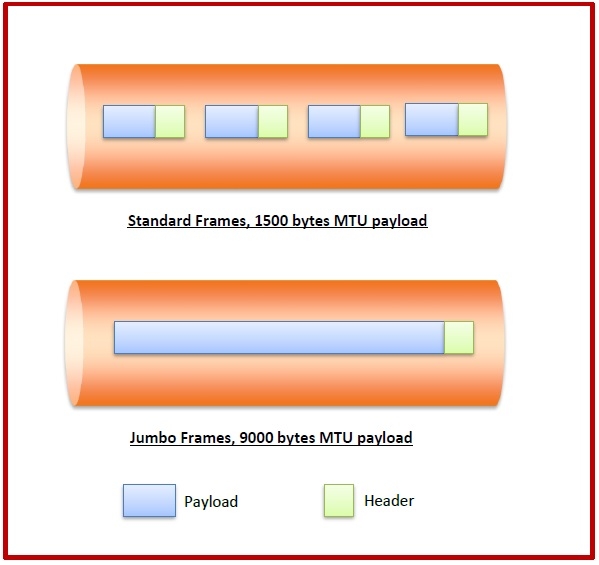
 Data Structure
Data Structure Networking
Networking RDBMS
RDBMS Operating System
Operating System Java
Java MS Excel
MS Excel iOS
iOS HTML
HTML CSS
CSS Android
Android Python
Python C Programming
C Programming C++
C++ C#
C# MongoDB
MongoDB MySQL
MySQL Javascript
Javascript PHP
PHP
- Selected Reading
- UPSC IAS Exams Notes
- Developer's Best Practices
- Questions and Answers
- Effective Resume Writing
- HR Interview Questions
- Computer Glossary
- Who is Who
Jumbo Frames in Computer Network
In computer networks, jumbo frames are Ethernet frames with payload size greater than 1500 bytes. Here, 1500 bytes is the maximum transmission unit (MTU) set by IEEE 802.3 standard. The maximum size of the jumbo frames is 9000 bytes.

Features
Jumbo frames are generally used in local area networks (LANs) with high data transmission rates of 1 Gbps (gigabits per second).
Jumbo frames are usually supported by a wide range of Gigabit Ethernet switches and Gigabit Ethernet network interface cards (NIC). Besides, a few fast Ethernet switches and fast Ethernet NIC also support them.
The interfaces must operate at speeds of 1000Mbps.
They can be of maximum size 9000 bytes, though there are variations.
The variations in their sizes arise since jumbo frames are not defined by IEEE 802.3 and so their usage depends upon vendor support.
Advantages
Since a larger payload is packed into each frame, processors have fewer frames to process.
The efficiency of the network is enhanced due to a reduction in the protocol overhead.
Reduction in a number of frames reduces the amount of heat the network devices generate.
Drawbacks
They increase network latency, particularly in links with low bandwidth.
The size of the jumbo frame is limited by the lowest frame size supported by the intermediate links in the connection. For example, if the token ring is used in the link, then the maximum frame size is limited to 4464 bytes.
The standard CRC error detection used in simple Ethernet frames is insufficient for detecting errors of large frames. This requires complex error detection algorithms that impose considerable overhead.

